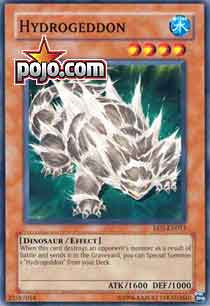|
|
||||||||
| Pojo's Yu-Gi-Oh! news, tips, strategies and more! | ||||||||
|
|
||||||||
 |
||||||||
|
Card Game Featured Writers Releases + Spoilers Anime Video Games Other
Magic
This Space |
DeathJester's Dojo Hello everyone! I’m back to Pojo.com with another Featured Article and hopefully more to come on a more frequent basis; 2 months is a LONG time.
This week’s article will be one in a series of others that will attempt to assess the Metagame in a more detailed way: Through testing and meticulous research. It’s one thing to analyze the metagame by looking at decks on your computer screen. It’s a whole new world actually taking those decks, building them, and playing them against one another.
Anyway, I’m back doing Featured Articles. I’ve received a ton of requests from my colleagues in the YGO community and here I am. ^_^ Enjoy!
How do the Gadgets work?
The New Year is coming around and we are going to receive some New Year’s gifts straight from Japan: The Gadgets. The infamous Gadgets are known for terrorizing the Japanese metagame for years as one of the most consistent decks of a few previous formats. It was so good in fact, that the Gadget deck, coupled with Death Caliber Knight, made our version of the Chaos Deck (with Chaos Sorcerer) look like a joke.
As a quick overview, the Gadgets are what I like to call ‘187 monsters’. It’s a term I borrowed from Magic: The Gathering’s ‘187 creatures’. It’s the exact same thing, but using a different vocabulary. '187 creatures (or monsters) are creatures that have their effects trigger when they hit the field in a certain fashion. This is a bit different from Ignition effects like Strike Ninja. These 187 creatures have their effects activate as a result of their summoning. The most popular 187 creatures are the Monarchs. Their effects trigger as soon as they are Tribute summoned to the field.
The Monarchs are excellent because they become 'floaters' (a term borrowed from Jae Kim) as soon as they hit the field. A 'floater' is a monster that has "paid for itself". A monster that pays for itself can also refer to a monster that '+1s' on your opponent. A monster that is Normal Summoned is deemed as a -1. You spent a resource to bring that monster to the field. That resource spent was a card in your hand. Once that monster destroys another monster in battle it has "+1ed" or "paid for itself." In other words, it allowed you gain a card of advantage on your opponent without using any additional resources.
How do Gadgets affect the Metagame?
Long before the announcement of the Gadget release, this question has been largely a matter of speculation. There hasn’t been much serious tournament testing against this deck-type until they were announced for release in January. Their effects generate instant +1s for the user, but require significant defensive back-up in order to make the most out of them.
Card advantage, in definitive terms, is just having more cards than your opponent at any given time. Card advantage does not necessarily lead to more options. This statement rings true with the Gadgets as well. When you summon a Gadget you are placing an additional monster into your hand; a Gadget. The Gadgets do not exceed more than 1400 ATK without any help. 1400 ATK isn’t really much to boast about compared to Cyber Dragon and the Monarch family.
Thus, to reiterate my previous point, Gadgets require heavy defensive support to perform optimally.
A good example of an American Gadget build can be found in Jason Grabher-Meyer’s article on Yugioh.TCGPlayer.com: http://yugioh.tcgplayer.com/db/article.asp?id=1767
The article covers the basic of
Gadgets and how they work. It’s good to educate
yourself about these monsters since they will be
played. Some Gadget builds may even play more Traps
and defensive Spells than Jason’s build.
The Gadgets themselves speed up any deck they are placed in. If you decide to include 3 copies of each into your deck, you may end up drawing them at the wrong time. Think about it this way: What if you were allowed to play 9 copies of Hydrogeddon. Would you play a smaller sized deck? No, you would include more cards into your deck to prevent 1) A self deck-out and 2) Having 2 copies of Hydrogeddon in your hand.
Gadget decks will have to run more than the minimum 40 cards just to stack the statistics in their favor. Gadget decks depend highly on consistent opening hands that don’t feature more than one copy of a Gadget. 45-card decks won’t be uncommon in the coming months.
A more detailed look at the Gadget threat
Gadget decks are very good; period. Despite their low ATK values they can compensate for that with more monster removal than you can possibly imagine. Add it up:
1. 3 Smashing Ground 2. 2-3 Fissure 3. 2-3 Shrink 4. 1-2 Rush Recklessly (Sometimes) 5. 3 Sakuretsu Armor 6. 2-3 Widespread Ruin or Bottomless Trap Hole 7. 1 Nobleman of Crossout 8. 1 Ring of Destruction 9. 1 Torrential Tribute 10. 1 Mirror Force
That totals up to about…21 Spells/Traps specifically geared towards monster removal. Keep in mind that this total does not take into account the monsters specifically designed to destroy other monsters like Exiled Force. Easily up to 30 cards in a 45-card deck are committed to destroying monsters. This is what Gadget decks favor since they’re instant +1 effect allows the Gadget player to play as many 1-for-1 trades as possible without suffering the reduction of resources.
When playing against a Gadget deck, you can expect to not have a monster on the field for more than 1 turn. How is that any different from now? Well…this statement will actually be true. Contrary to popular belief, the average life span of a creature in today’s format is about 2-3 turns. Playing against a Gadget deck is like throwing your monsters into a mine field.
A Gadget deck can play Solemn Judgment as reliable response to the majority of most threats. Here’s my attempt at a Gadget deck with Solemn Judgment:
.
This is a Warrior Toolbox variant of Gadgets. You could also play a Machine version. Gadgets are pretty versatile. If you don’t have Shrink, you can still use Rush Recklessly. Sometimes your version can contain Chiron the Mage or Mobius the Frost Monarch.
Countering the Gadgets
I’ve seen post upon post about countering the Gadgets. Gadgets are a bit over-hyped. There are ways to counter them. None of which require an entire deck built to beat them. Here are some ways to counter Gadgets and the drawbacks to each:
Applying this information to your testing pool
Last night, I took the opportunity to test some of these theories with my teammate Andre Correa as a part of our weekly team practice. The first thing we did is test the Gadget deck I have listed in this article versus the current reigning Monarch deck: The Ryan Spicer build that piloted by Hooman in SJC Anaheim.
The results out of 10 un-side boarded games ended up putting Gadgets with a 60% win percentage over the Monarch deck. That’s a good sign. However, it’s easy to take this number too seriously. It’s only 10 games after all. At the same time the Gadget deck itself is NOT broken, but extremely consistent. If you summon a Gagdet every turn, you will have a monster every turn. The deck is always generating +1 after +1 after +1 after +1. I like how the deck plays, but it takes some serious forethought. There are moments where you can overload your hand with Gadgets. At that point, you better hope you have enough monster removal to counter your opponent’s creatures.
The Monarch build I ran during the first half of testing, which was Hooman Farahbakhsh’s deck, had trouble keeping up. Thankfully it runs 23 creatures. Here are some plays that gave me some positive results against the Toolbox version of the Gadget deck:
What should you get out of this research?
Since I went through the trouble of doing this meticulous research for you guys ^_^, I would hope you finish this article with a better understanding of this imminent metagame threat. Of course, this small amount of research won’t put to rest the endless debates of the effects of Gadgets on our metagame in the future. My team and I still have many unanswered questions like:
In the end, it’s all speculation until the Regional and SJC result start pouring in. Hopefully I have brought a bit more clarity to this highly debated issue; looking at it from both sides of the spectrum. The more informed you are the better chances you’ll have of succeeding in what I feel will be a radically changing format in the next 3 months. I will be conducting more detailed research and I will be posting the up-to-the-minute info on my YGO blog at: http://www.thebestyugiohblog.blogspot.com/.
This research will be formulated into more detailed and highly informative articles on Pojo.com as the weeks go by. I’m looking forward to reporting more of the latest developments to the largest YGO audience on the internet: Pojo.com.
|
|||||||
|
Copyrightę 1998-2006 pojo.com This site is not sponsored, endorsed, or otherwise affiliated with any of the companies or products featured on this site. This is not an Official Site. |
||||||||


